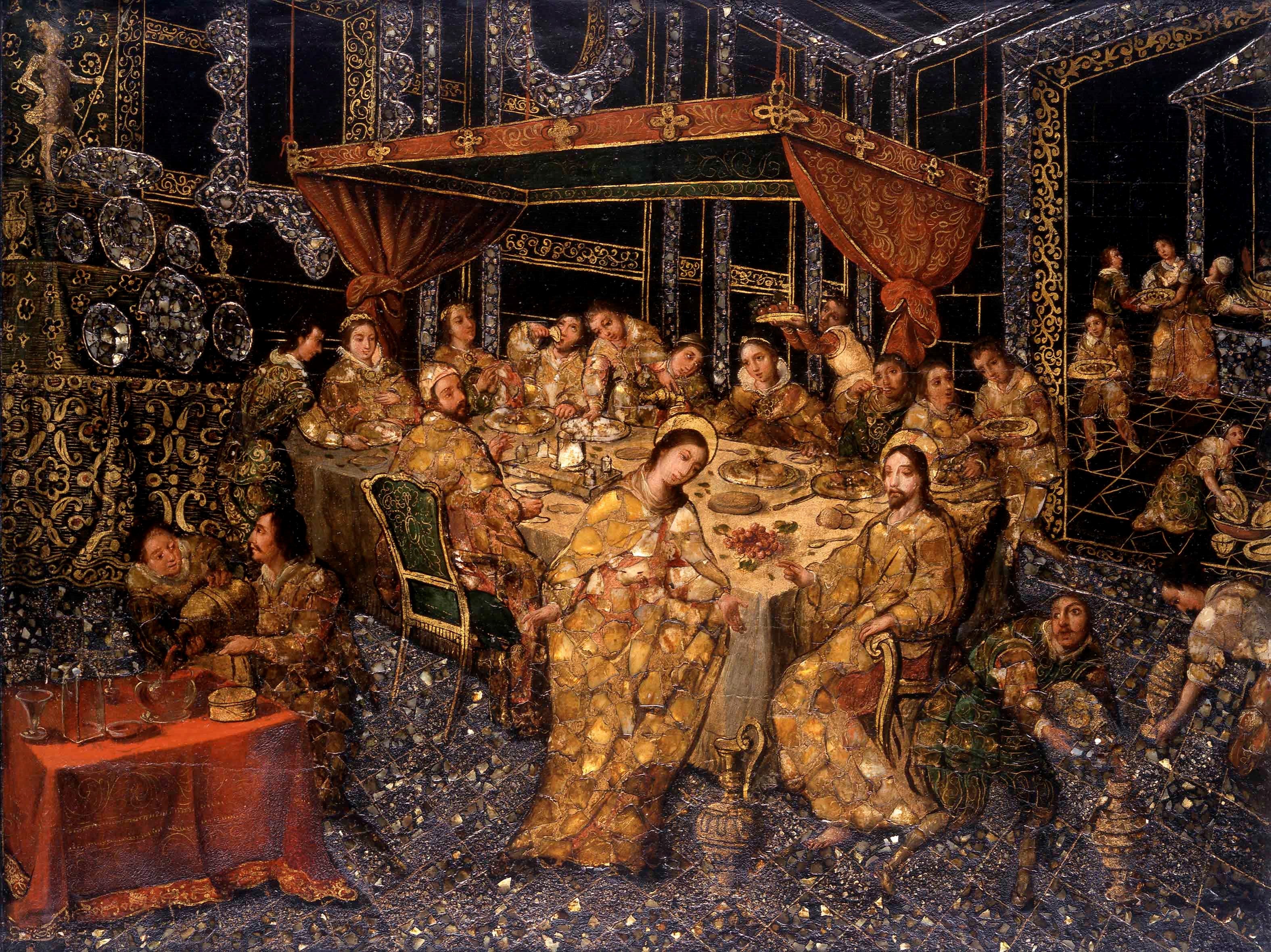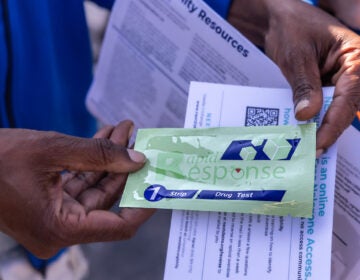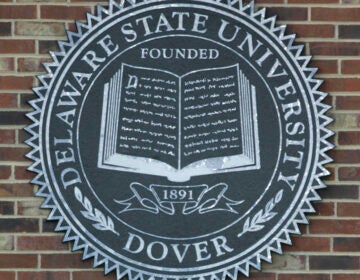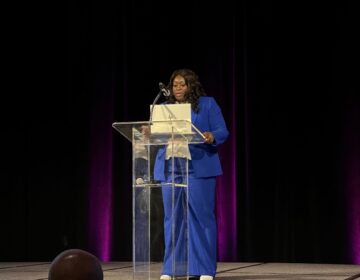Winterthur Museum brings history of globalization to Delaware
Listen
The Wedding at Cana. Nicolas Correa (born 1670/75). 1693 mixed media with encrusted mother-of-pearl on pane. On loan from The Hispanic Society of America
The term globalization is a modern one but a new exhibit at Winterthur Museum, Garden & Library shows that it might merely be a new name for a centuries-old phenomenon.
“Made in the Americas: The New World Discovers Asia,” which runs through January 8, 2017 in the museum’s galleries, takes a fresh look at globalization as it explores the impact of Asian styles on American designs in the colonial Americas.
The landmark display is the first large-scale Pan-American exhibition of its kind. More than 80 works—including fine furniture, textiles, ceramics, silverwork and paintings dating from the 17th to the early 19th centuries—illustrate the complex story of how craftsmen throughout the hemisphere adapted Asian sensibility to their art.
The exhibition features works from Boston’s Museum of Fine Arts, Winterthur and on loan from public and private collections. Many are on display for the first time.
“This is the first exhibit of its kind to explore the influence of Asia in the colonial Americas,” says exhibit curator Dennis Carr. “Globalization had its roots in the 16th century. America became the hub of trade activity—silk textiles from China, cotton from India, ivories from Goa and the Philippines. Then artists began creating hybrid product. The Americas became a melting pot in the 16th century. This exhibition shows globalization through the eyes of artists.”
Carr is a graduate of the Winterthur Program in American Material Culture and Carolyn and Peter Lynch Curator of American Decorative Arts and Sculpture at the Museum of Fine Arts in Boston.
Carr says “Made in the Americas” presents a history not taught in schools. His research is prompting scholars to reevaluate curricula relative to the period.
The fashion of Asian art as a decorative style, today known as chinoiserie (“in the Chinese taste”), was in vogue during the colonial period, reaching the height of its popularity in the mid-18th century. In the Americas, the style manifested itself in lavishly painted and decorated interiors, furniture, ceramics, silverwork, textiles and paintings.
Visitors to “Made in the Americas” will see impressive objects made in Mexico City, Lima, Quito, Quebec City, Boston, New York and Philadelphia dating from the 17th to the early 19th centuries reflecting the influence, including blue-and-white talavera ceramics copied from Chinese porcelain and luxuriously woven textiles made to replicate fine silks and cottons from China and India.
One of the rarest—and most impressive– pieces of furniture in the exhibit is a mid-18th century desk-and-bookcase which features a dramatic interior displaying chinoiserie-style painting in gold on a red background. Recalling early colonial maps drawn by indigenous artists, the inside of the doors show views of an extensive hacienda in Veracruz drawn in an indigenous style. The geometric designs on the exterior are Spanish-Islamic in style.
A practice known as japanning—a painted imitation of Asian lacquer work on furniture and wall paneling using layers of varnish, gold paint and, sometimes metallic powders–was also popular throughout the New World during the 18th century.
In North America, Boston became a major center of japanned furniture but it was also produced in Mexico, Guatemala and Brazil as well as other port cities such as New York, Philadelphia and Port Royal, Jamaica. Representative pieces from Winterthur’s collection include a high chest and clock.
Because indigenous artisans did not have access to the tree resin needed to produce Asian lacquers, they developed new styles and techniques from a mixture of oils from the aje beetle and chia seeds, clay and organic and mineral colorants.
Furniture-making in Peru featured a variety of precious materials, notably mother-of-pearl and tortoiseshell. Described in Spanish as enconchado, or shellwork, the objects recall the elaborate Japanese shell-inlaid lacquers or fine inlaid furniture imported from India, Korea and other parts of Asia. The exhibit features a pair of enconchado writing cabinets from Alto Peru, now modern-day Bolivia.
Southeast of Mexico City, along the trade route that brought Asian goods overland from Acapulco, a ceramics tradition based on imported Chinese blue-and-white porcelains flourished in the town of Puebla. Like colonial japanners, Puebla potters did not have access to the fine materials needed to create true porcelains so they covered earthenware pottery with a thick, white tin glaze decorating it with expensive cobalt blue. In some of these ceramics, known as talavera poblana, artists replaced Chinese imagery with native quetzals, small birds with long, colorful tail feathers.
China’s growing appetite for silver helped fuel the robust trade with the Americas. Likewise, colonial silver was an important part of chinoiserie style in the New World. As demand for Chinese tea grew in the 18th century, colonial silversmiths produced vessels in the Asian style. These included teapots, hot-water urns, tea caddies, strainer spoons, creamers and sugar bowls, many of which are on display in the exhibit.
Chinese silks as well as Persian and Indian textiles were also extremely popular in the Americas and a variety of Asian and American textiles are displayed in the exhibit. An important part of the Asian textile trade was the wide array of colorful cottons from India, which came to the Americas through Manila as well as from European ports. The exhibit also includes an intricately embroidered hanging from Peru dated 1661.
There are a number of paintings in the display, including a portrait from Mexico—”Maria de los Dolores Juliana Rita Nunez de Villavicencio”—that shows a young noble woman wearing an embroidered dress decorated with a menagerie of imagery from China, Europe and the Near East.
An illustrated catalogue of essays—”Made in the Americas: The New World Discovers Asia”—accompanies the exhibit. The essays were written by a team of experts, including Carr.
The exhibit debuted in Boston last year to mark the 450th anniversary of the Galleon trade between the Philippines and Mexico, inaugurated in 1565 and ending in 1815 two and a half centuries later. The Winterthur exhibit, which is organized by the Museum of Fine Arts, Boston, features new additions from the Winterthur collection.
For more information, visit www.winterthur.org or call 302-888-4600 or 800-448-3883
WHYY is your source for fact-based, in-depth journalism and information. As a nonprofit organization, we rely on financial support from readers like you. Please give today.




